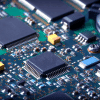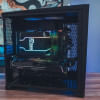Things you need to know before buying Intel motherboards

When it comes to building or upgrading your PC, the motherboard you choose plays a pivotal role in determining your system's performance and capabilities. Whether you're eyeing a 14th Gen, 13th Gen, or 12th Gen Intel CPU, these are some of the key things you need to know before buying an Intel motherboard for your PC.
Understanding chipsets
Chipsets are crucial neural pathways that facilitate seamless communication between CPU, GPU, RAM, storage devices, and peripherals, playing a pivotal role in the system's functioning. The motherboard chipsets landscape can be confusing, from B660 to B760, Z690 to Z790, and H610 and beyond. To navigate this, focus on the number immediately following the letter in the chipset name, such as the '6' in Z690. This number represents the generation of the motherboard, often referred to as the series.
Chipsets in the 600 and 700 series, like B660 and B760, are designed for the LGA 1700 socket, which supports Intel's 14th, 13th, and 12th Gen CPUs. The 600 series debuted with the 12th Gen Intel launch, and the 700 series was introduced with the 13th Gen. Note that no new chipset is launching for the 14th Gen, but several motherboard manufacturers are releasing newer Z790 versions.
Z series vs B series
The Z series motherboards, like Z690 and Z790, are tailor-made for overclocking unlocked K series CPUs. They offer double the PCIe lanes, which means they generally have a lot more USB and other rear panel connections. These motherboards are a bit pricier but well-suited for maximising the potential of 13th and 14th Gen CPUs. Furthermore, many Z790 motherboards have better DDR5 memory traces, which help compatibility and stability when using ultra-fast DDR5 RAM, particularly with higher-end gaming builds.
For locked Intel CPUs and older unlocked 12th Gen CPUs, particularly the i5 12600k, B660 and B760 motherboards are great choices. The main difference is that the B series motherboards can't overclock the K series unlocked CPUs like the i5 14600k. However, B series motherboards allow full RAM overclocking, including XMP Auto overclocking profiles. While they have fewer PCIe lanes than Z series boards, they are generally more budget-friendly.
Deciphering the H Series
H series chipsets offer ultra-budget motherboards, which are similar to the B series but have limitations like a capped DDR4 memory speed of 3200MHz. These boards are not recommended for specific reasons. For those seeking more flexibility, H660 and H760 boards are equivalent to B660 and B760. So, if you are in a tight spot and find them at a reasonable price, treat them as B series motherboards.
Which one should you choose?
Your choice between DDR4 and DDR5 on Intel's 14th, 13th, and 12th Gen CPUs is determined by your motherboard. Many LGA 1700 motherboards come in two versions, one for DDR4 and another for DDR5, as these RAM types use different technologies and have different physical sockets.
For example, DDR5 RAM has a dual-channel design, meaning that each RAM stick can operate on two channels simultaneously. On the other hand, DDR4 RAM has a single-channel design, meaning that each RAM stick can only operate on one channel at a time. When you purchase the motherboard, your RAM choice becomes fixed, so ensure it aligns with your RAM preference. Otherwise, it will affect the performance and compatibility between your PC components.
Bios flashback
Motherboard BIOS and bios flashback are really important for Intel motherboard selection. The BIOS is the operating system for the motherboard, and it's vital for compatibility. Older boards released before the 13th or 14th Gen Intel launches may not have updated bios and won't boot out of the box. However, many modern boards come with BIOS flashback features, allowing you to update the BIOS without a compatible CPU. You just need to download from the motherboard manufacturer's website to do so. Unfortunately, not all motherboards offer this option. So, when selecting a 600 or 700 series board, ensure it has a BIOS flashback option.
Size does matter
There are four mainstream motherboard sizes: ATX, microATX (mATX), ITX, and Extended ATX (eATX). ATX motherboards have more expansion slots and ports but require larger cases, while microATX is smaller and cheaper but has fewer slots and ports. ITX is a miniature-size motherboard with only one PCIe slot and is more expensive. An Extended ATX (eATX) motherboard is slightly larger and fits most ATX-size cases. That's why most of you will likely want either a full-size ATX or a microATX motherboard. The PC case you buy needs to fit the motherboard, and while small motherboards will fit into larger cases, ATX motherboards cannot fit in cases designed exclusively for smaller boards. So, check your specs and compatibility before you buy a case.
Powering your CPU
Voltage Regulator Module (VRM) is the little half square on the top left corner of your motherboard that delivers power to your CPU. While most boards advertise that they're compatible with any Intel CPU up to an i9, in reality, cheap cut-down motherboards often lack the proper VRMs for high-core-count CPUs, leading to overheating and performance throttling, which could affect the CPU's lifespan and stability. A recommended choice would be investing in a good quality Z series motherboard for the higher core count and higher power draw CPUs like the unlocked i5 14600k and 13600 K and higher CPUs.
PCIe Gen 5 compatibility
PCIe Gen 5 internal motherboard lanes allow you to connect more Gen 3 and Gen 4 devices to your motherboard, but when it comes to SSD and GPU slots rated to run at Gen 5 speed, you should not spend extra money to get them. As such, it is wise to not overspend on PCIe Gen 5 compatibility.
Gen 5 GPUs don't exist yet, and PCIe Gen 4 will be fine for years to come for GPU bandwidth. For SSDs, most users barely take advantage of SATA SSD speeds, especially in gaming, let alone NVMe PCIe Gen 3 or Gen 4 speeds. Likely, PCIe Gen 5 GPUs and SSDs won't offer any tangible benefits during the relevant lifespan of your PC build. Try not to chase this feature; save your money for other essential components.
M.2 and SATA storage
Consider the number of M.2 connectors on your motherboard, ranging from one to five. There are two primary types of M.2 connectors: one for storage devices and the other for M.2 for Wi-Fi adapters. These connectors can run at different maximum speeds, from PCIe Gen 3 to the newest and ludicrous Gen 5. Many motherboards now come with built-in heat sinks for the M.2 drive. So, consider that before you buy an SSD with a pre-installed heat shield. Additionally, most motherboards offer at least four SATA drive connectors.
Unraveling the sound experience
Motherboard audio is a crucial component in audio systems but is often overlooked. It's in the bottom and corner of the board and comprises capacitors and a Realtek audio codec chip. Budget audio codecs like ALC 897 sound fine, while premium audio codecs like ALC 1200 offer better overall signal-noise ratios and an additional audio signal boost for front-panel headphones. Enthusiasts will say to go for ALC 1220 or the newer but very similar ALC 4080. Both of these top-tier audio codecs not only guarantee pristine audio output but also offer advanced encoding and decoding support, as well as support for high-impedance headphones.
USB connectivity
USB connectivity, starting with the rear panel, can come in several speeds and connection types. Most boards offer a range of USB A connections ranging in speed from USB 2.0, like your mouse and keyboard. Those are usually the black USB connections. The USB 3.2 Gen 1 is typically coloured blue, and USB 3.2 Gen 2 connections are often red. There are also USB type-c connectors, which are smaller but faster. Motherboards also have headers to plug in the front PC case USB connections, USB 3.2 and slower 2.0 ports, and some come with a USB type-c header.
Networking & Wi-Fi
Motherboards typically include wired ethernet; some offer built-in Wi-Fi with Bluetooth connectivity. Try to buy the latest Wi-Fi and Bluetooth options; alternatively, you can purchase adapters for wireless connectivity later.
Before buying an Intel motherboard on your own, it is best to not rely only on what the retailers tell you. Some may not understand your needs and preferences. Instead, do your own research and learn from trustworthy sources on the internet. Buy only what you want and need, not what they want you to buy. Remember, it's better to buy wisely than to buy twice.

 For all latest news, follow The Daily Star's Google News channel.
For all latest news, follow The Daily Star's Google News channel. 






Comments